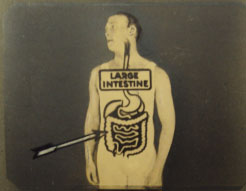Want to read a great big chunk of formal prose? Of course you do! This is an excerpt from the introduction to my dissertation, which is called Depth Perception. Here, I attempt to explain why anyone would write (or care) about medical films.

When we picture the human body, what do we see? The answer is less obvious than it might seem, and it depends a great deal on whom one asks. We might care about this question because the answer suggests that seeing the body is not a simple matter of opening our eyes. Making the body coherent — arranging its parts in logical, comprehensible sequences of cause and effect — requires complex sets of cognitive operations. The complexity of these procedures should give us pause: if visualizing something as “universal” as the human body is so complicated, perhaps the body is not so universal or so self-evident as we’ve thought. Nor is the body so immediately comprehensible; indeed, bending the body into coherence takes deliberate, continuous effort. The body, I argue, has a tendency to fall into disarray. It is only by telling stories about our bodies that we can make the pieces cohere.
*****


